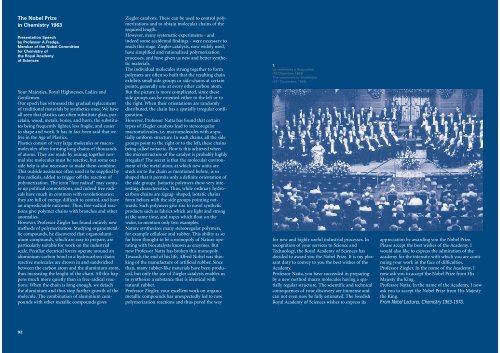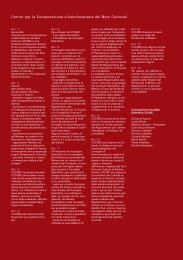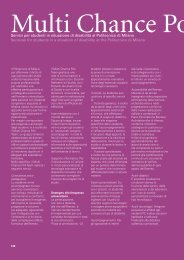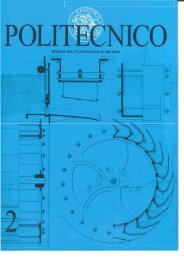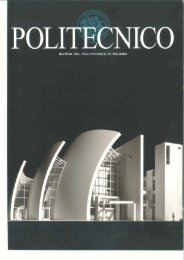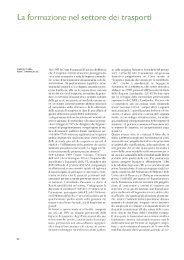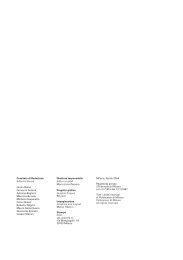Scarica il PDF (1959KB) - Rivista Politecnico - Politecnico di Milano
Scarica il PDF (1959KB) - Rivista Politecnico - Politecnico di Milano
Scarica il PDF (1959KB) - Rivista Politecnico - Politecnico di Milano
You also want an ePaper? Increase the reach of your titles
YUMPU automatically turns print PDFs into web optimized ePapers that Google loves.
The Nobel Prize<br />
in Chemistry 1963<br />
Presentation Speech<br />
by Professor A.Fredga,<br />
Member of the Nobel Committee<br />
for Chemistry of<br />
the Royal Academy<br />
of Sciences<br />
Your Majesties, Royal Highnesses, La<strong>di</strong>es and<br />
Gentlemen.<br />
Our epoch has witnessed the gradual replacement<br />
of tra<strong>di</strong>tional materials by synthetics ones. We have<br />
all seen that plastics can often substitute glass, porcelain,<br />
wood, metals, bones, and horn, the substitutes<br />
being frequently lighter, less frag<strong>il</strong>e, and easier<br />
to shape and work. It has in fact been said that we<br />
live in the Age of Plastics.<br />
Plastics consist of very large molecules or macromolecules<br />
often forming long chains of thousands<br />
of atoms. They are made by joining together normal<br />
size molecules must be reactive, but some outside<br />
help is also necessary to make them combine.<br />
This outside assistance often used to be supplied by<br />
free ra<strong>di</strong>cals, added to trigger off the reaction of<br />
polymerization. The term “free ra<strong>di</strong>cal” may conjure<br />
up political connotations, and indeed free ra<strong>di</strong>cals<br />
have much in common with revolutionaries:<br />
they are full of energy, <strong>di</strong>fficult to control, and have<br />
an unpre<strong>di</strong>ctable outcome. Thus, free-ra<strong>di</strong>cal reactions<br />
give polymer chains with branches and other<br />
anomalies.<br />
However, Professor Ziegler has found entirely new<br />
methods of polymerization. Studying organometallic<br />
compounds, he <strong>di</strong>scovered that organoaluminium<br />
compounds, which are easy to prepare, are<br />
particularly suitable for work on the industrial<br />
scale. Peculiar electrical forces operate around an<br />
aluminium-carbon bond in a hydrocarbon chain:<br />
reactive molecules are drown in and sandwiched<br />
between the carbon atom and the aluminium atom,<br />
thus increasing the lenght of the chain. All this happens<br />
much more quietly than in free-ra<strong>di</strong>cal reactions.<br />
When the chain is long enough, we detach<br />
the aluminium and thus stop further growth of the<br />
molecule. The combination of aluminium compounds<br />
with other metallic compounds gives<br />
92<br />
Ziegler catalysts. These can be used to control polymerizations<br />
and to obtain molecular chains of the<br />
required length.<br />
However, many systematic experiments - and<br />
indeed some accidental fin<strong>di</strong>ngs - were necessary to<br />
reach this stage. Ziegler catalysts, now widely used,<br />
have simplified and rationalized polymerization<br />
processes, and have given us new and better synthetic<br />
materials.<br />
The in<strong>di</strong>vidual molecules strung together to form<br />
polymers are often so bu<strong>il</strong>t that the resulting chain<br />
exhibits small side groups or side-chains at certain<br />
points, generally one at every other carbon atom.<br />
But the picture is more complicated, since these<br />
side groups can be oriented either to the left or to<br />
the right. When their orientations are randomly<br />
<strong>di</strong>stributed, the chain has a spatially irregular configuration.<br />
However, Professor Natta has found that certain<br />
types of Ziegler catalysts lead to stereoregular<br />
macromolecules, i.e. macromolecules with a spatially<br />
uniform structure. In such chains, all the side<br />
groups point to the right or to the left, these chains<br />
being called isotactic. How is this achieved when<br />
the microstructure of the catalyst is probably highly<br />
irregular? The secret is that the molecular environment<br />
of the metal atom, at which new units are<br />
stuck on to the chain as mentioned before, is so<br />
shaped that it permits only a definite orientation of<br />
the side groups. Isotactic polymers show very interesting<br />
characteristics. Thus, wh<strong>il</strong>e or<strong>di</strong>nary hydrocarbon<br />
chains are zigzag- shaped, isotatic chains<br />
form helices with the side groups pointing outwards.<br />
Such polymers give rise to novel synthetic<br />
products such as fabrics which are light and strong<br />
at the same time, and ropes which float on the<br />
water, to mention only two examples.<br />
Nature synthesizes many stereoregular polymers,<br />
for example cellulose and rubber. This ab<strong>il</strong>ity as so<br />
far been thought to be a monopoly of Nature operating<br />
with biocatalysts known as enzymes. But<br />
now Professor Natta has broken this monopoly.<br />
Towards the end of his life, Alfred Nobel was thinking<br />
of the manufacture of artificial rubber. Since<br />
than, many rubber-like materials have been produced,<br />
but only the use of Ziegler catalysts enables us<br />
to synthesize a substance that is identical with<br />
natural rubber.<br />
Professor Ziegler, your excellent work on organometallic<br />
compounds has unexpectedly led to new<br />
polymerization reactions and thus paved the way<br />
1.<br />
La cerimonia a Stoccolma<br />
(10 Dicembre 1903)<br />
The ceremony in Stockholm<br />
(10 th December, 1963)<br />
for new and highly useful industrial processes. In<br />
recognition of your services to Science and<br />
Technology, the Royal Academy of Sciences has<br />
decided to award you the Nobel Prize. It is my pleasant<br />
duty to convey to you the best wishes of the<br />
Academy.<br />
Professor Natta, you have succeeded in preparing<br />
by a new method macro molecules having a spatially<br />
regular structure. The scientific and technical<br />
consequences of your <strong>di</strong>scovery are immense and<br />
can not even now be fully estimated. The Swe<strong>di</strong>sh<br />
Royal Academy of Sciences wishes to express its<br />
appreciation by awar<strong>di</strong>ng you the Nobel Prize.<br />
Please accept the best wishes of the Academy. I<br />
would also like to express the admiration of the<br />
academy for the intensity with which you are continuing<br />
your work in the face of <strong>di</strong>fficulties.<br />
Professor Ziegler. In the name of the Academy, I<br />
now ask you to accept the Nobel Prize from His<br />
Majesty the King.<br />
Professor Natta. In the name of the Academy, I now<br />
ask you to accept the Nobel Prize from His Majesty<br />
the King.<br />
From Nobel Lectures, Chemistry 1963-1970.


